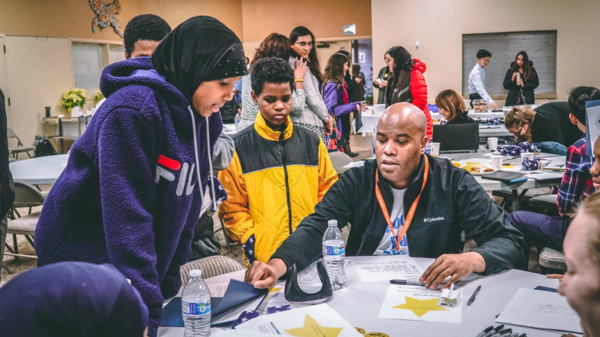“What’s a constituent?” the boy asks quizzically, after sounding out the word with a staff member sitting at the table with him. “A constituent,” Amir Noir Soulkin enunciates, “is someone who can vote for a legislator because of where they live. You could say you live in Seattle.” The boy nods and returns to the worksheet in front of him, which lays out how to effectively tell a story to elected officials. The kids and staff from East African Community Services, all wearing custom t-shirts that say, “Advocacy Day 2020!” in bold blue letters, are dutifully crafting their talking points in preparation for the upcoming meetings with their district’s state senators and representatives. It’s the third year in a row that EACS has come down to Olympia from Seattle’ NewHolly neighborhood to join other youth-serving organizations from around the state and collectively urge legislators to grow and maintain support for our field.
About a month prior, EACS staff were gathered with fellow Best Starts OST cohort members in the Burien Community Center for a workshop on storytelling– specifically, how organizations can harness their experience and expertise and, whether it be for marketing, development, or advocacy, communicate on their terms. After being introduced to tools and frameworks to help them maintain agency when sharing their stories, (like former Black Lives Matter Communications Director Shanelle Matthews’ Narrative Power Analysis that, “helps us understand the story we are trying to change, identify the underlying assumptions that allow the story to operate as truth, and find the points of intervention in the story where we can challenge, change, and/or insert a new story”), participants created a mock front page of a newspaper that honored their programs.

Despite some anxiety about drawing skills, or how much program data they had swimming in their heads, everyone created compelling, unique ways of telling their individual stories. As groups presented their work back to the large group, there was laughter, a sea of nodding heads, and cheers of celebration.
At the end of the workshop, SOWA’s Policy and Advocacy Director David Beard joined the fun by drumming up support for the upcoming Youth Development Advocacy Day. “This is an opportunity to make sure that policy makers that are directly representing your communities hear your voice and hear how impactful all of your programs are!” And just this week, many of those same Best Starts cohort members who had practiced their storytelling strategies at the workshop in Burien, gathered with fellow youth service providers to collectively advocate for robust statewide support of their organizations.
“Attending Advocacy Day was important because it provided us the opportunity to share the collective stories of our work with youth, highlight the strengths in our communities, and advocate for state funding and support,” said Heather Hallman of Southwest Youth & Family Services. Andy Pham of Neighborhood House says he, “loved meeting all of the other organizations in attendance who shared the same passions, missions, and goals. I had a chance to share my on-the-ground experiences with legislators that could champion for expanded learning opportunities.” What both events show is that providers have the power to be their own champions, too.
